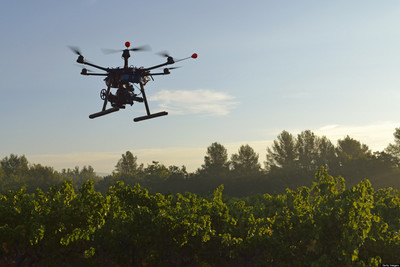Watch the Skies: Commercial Drone Shipments to Surpass 2.6 Million Units Annually by 2025
 Farm Drone |
Key Industries Utilizing Small Unmanned Aircraft Systems Will Include Film, Media, Agriculture, and Oil & Gas
BOULDER, CO -- July 21, 2015: The utilization of unmanned aerial vehicles (UAVs), also known as unmanned aircraft systems (UASs) or drones, for commercial applications has a great deal of potential to be explored and exploited. Companies, universities, and government agencies are all actively assessing the opportunity for drones to disrupt some industries and creative innovative business models in others.
“Key industries that will drive the adoption of commercial drones include film, media, agriculture, and oil & gas. Meanwhile, the strong growth in the drone-enabled services market will be driven by applications such as filming & entertainment, mapping, aerial assessments, prospecting, and disaster relief.”
According to a new report from Tractica, this interest in utilizing drones for commercial applications will drive commercial-grade UAV shipments from 80,000 in 2015 to more than 2.6 million units annually by 2025. The market intelligence firm forecasts that annual revenue from commercial drone hardware sales will reach nearly $4 billion within the same timeframe. However, the more significant revenue opportunity will be in commercial drone-enabled services, which Tractica forecasts will grow to $8.7 billion annually by 2025.
“The two primary application categories in the commercial drone sector are aerial imaging and data analysis,” says managing director Clint Wheelock. “Key industries that will drive the adoption of commercial drones include film, media, agriculture, and oil & gas. Meanwhile, the strong growth in the drone-enabled services market will be driven by applications such as filming & entertainment, mapping, aerial assessments, prospecting, and disaster relief.”
Wheelock adds that, despite the significant interest in utilizing small unmanned aircraft systems as cost-effective tools for aerial photography and data analysis, the industry continues to face significant challenges that will need to be addressed in order for the sector to truly take off. Key factors include regulatory policy, public perception, safety, and privacy. In particular, regulatory bodies currently lag behind technological advances and market demand is already exerting significant pressure on government agencies to enact policy reform.


